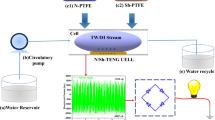Abstract
THE current tendency to use oil instead of mercury vapour in diffusion pumps led us to carry out experiments of two kinds on secondary electron emission using silicone oil (DC. 703). From our findings, we consider that its vapour will produce obnoxious results on any surface when bombarded by electrons.
This is a preview of subscription content, access via your institution
Access options
Subscribe to this journal
Receive 51 print issues and online access
$199.00 per year
only $3.90 per issue
Buy this article
- Purchase on Springer Link
- Instant access to full article PDF
Prices may be subject to local taxes which are calculated during checkout
Similar content being viewed by others
References
“Advances in Electronics”, 2, Garlick, G. F. J., “Cathodoluminescence”, 158.
Bull, C. S., and Atherton, A. H., J. Inst. Elect. Eng., 97, III, 65 (1950).
Author information
Authors and Affiliations
Rights and permissions
About this article
Cite this article
LEMPICKI, A., McFARLANE, A. Silicone Oil Vapour and Secondary Electron Emission. Nature 167, 813–814 (1951). https://doi.org/10.1038/167813a0
Issue Date:
DOI: https://doi.org/10.1038/167813a0
Comments
By submitting a comment you agree to abide by our Terms and Community Guidelines. If you find something abusive or that does not comply with our terms or guidelines please flag it as inappropriate.



